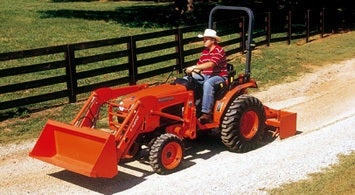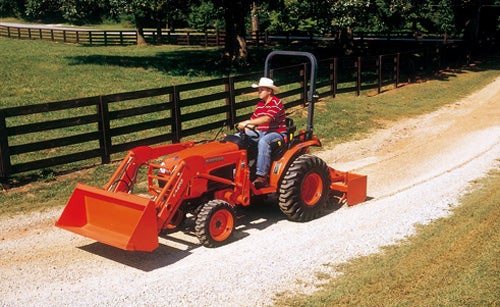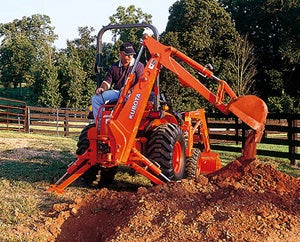
The Kubota B-Series covers a wide range of models, ranging from 23 to 33 horsepower. For this review I chose the 2620 (more on this later), but the first task at hand was to decipher the Kubota numbering system, which when explained, made more sense. The nomenclature defines first the series (in this case the B), then the gross horsepower rating (in this case 26), and the last two digits, the comfort level (in this case the twenty series “standard” trim vs. the “premium” level of its close cousin, the 2630).
“Standard” though the reviewed series may be, when it comes to features, it’s hard to imagine what more a small frame CUT (compact utility tractor) user would need.
All Kubota tractors come with Kubota-manufactured engines. The 2620 comes with a 3-cylinder diesel that produces 19 horsepower at the PTO (power take off). The engine is a high torque liquid-cooled powerplant that is surprisingly quiet, even at rated RPM. It is also Interim Tier 4 compliant (EPA Tier 4 Final compliance takes place in 2012), which means the emissions are clean and I found the engine virtually smoke-free, even under load.
 |
A big selling feature for the hydrostatic transmission equipped tractors in this series is the 3-range hydro. Whereas the competition goes with a 2-range hydro that can sometimes leave you in an overlapping condition wishing for more power though not at the expense of speed, or more speed but not at the expense of power, the 3-range transmission comes through with the goods. L is a grunt and get it done range where it’s hard to imagine a circumstance where more power to the ground would be needed. M is more suited for mid range work such as mowing or snowblowing. And H, with its 12.6 mph top forward speed, is perfect for transport needs.
The 2620 hydraulics are powered by an 8.3 gal/min twin pump that keeps implement needs separate from the power steering. The 3PH (three point hitch) is powerful, rated to lift 1058 lbs. 24” behind the link point, but lacks true position control. Kubota makes up for this with its Quarter Inching Valve, which is a step up from an up down only 3PH control, but makes you pay attention to the number of up/down strokes. To get an idea of how this system works, the operator pushes the Rockshaft control lever to the mid stop and the hitch lifts ¼” inch at the end of the 3PH for each stroke back to the mid lever position. The same goes for down but you push in the opposite direction.

The 2620 tested came with the LA364 loader that is rated to lift 952 lbs. at max height. I found the hydraulics responsive and a big step up from the BX series, which can have you napping a bit while lifting/lowering and curling/dumping. The loader comes with stands built into the arms and is easy to take off and reinstall. Three (54”, 60” and 72”) mid-mount mowers are offered (the 54” and 60” allow the loader to be installed at the same time), as-well-as implements such as a backhoe, front blade, front and rear mounted snowblowers, and a nifty front sweeper that can do everything from clean your driveway or parking lot to remove snow right down to bare pavement.
Ergonomics are well thought out and everything fell exactly where you felt it should be. Kubota does use a treadle pedal that some like and others dislike, but I felt it was easy to get used to (a big tip goes to the salesman who told me to keep my heel on the platform instead of the reverse portion of the pedal). The range control, 3PH, throttle, 4WD, and PTO selector levers were all clearly marked, and I especially liked the large backlit gauges with white backgrounds that were as easy to read in bright sunlight as they were when illuminated at night. And the headlights—Kubota calls them multi-reflective—were bright and well-positioned.
As stated earlier, I chose this model because of the competition, specifically the John Deere 2520 and New Holland Boomer 1025/30 – each being time-tested and proven designs. For this review, I’ve chosen two areas that may make a difference to prospective purchasers, leaving the little personal preferences for others and another day. Those areas are number of transmission ranges and method of control over the 3PH. The Deere 2520 comes with a 2-range hydro and position control on the 3PH. The Boomer 1025 has a 2-range hydro and Self-centering Valve for controlling the 3PH; the 1030, which gets you into the next-higher horsepower range, has a 2-range hydro and position control. My preference for 3PH control is the position control used on the Deere 2520 and Boomer 1030, but the Quarter Inching Valve on the Kubota is easy to get used to and certainly an improvement over a up/down system. But when it comes to transmission ranges, the 3-range hydro used by Kubota puts this small frame tractor into the league of bigger machines. Score a big advantage for Kubota with this feature.
For those considering a B-Series tractor, Kubota’s 0% – 60 month financing might just be the sweetener to bring one of these capable machines home today.
Related Reading
2011 John Deere 2520 4WD Compact Tractor Review
 Your Privacy Choices
Your Privacy Choices